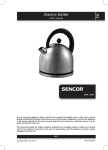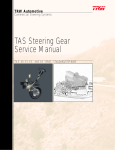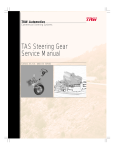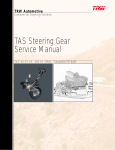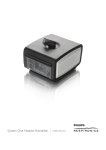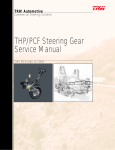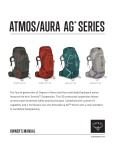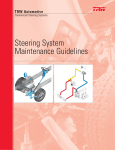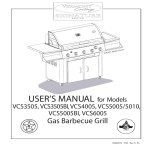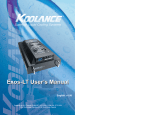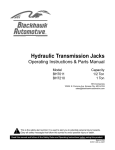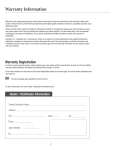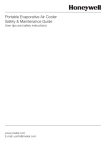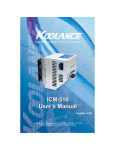Download TRW Tas100
Transcript
TRW Automotive Commercial Steering Systems Service Procedure #TAS-100 On-Vehicle Input Shaft Seal Replacement for TAS/THP Series Steering Gears. Service Kit #TAS000001 Revised July, 2005 CAUTION Do not mix engine oil and ATF in the power steering system. This TRW Commercial Steering Systems' service procedure has been written to help you repair commercial vehicles more efficiently. This procedure should not replace your manuals; you should use them together. These materials are intended for use by properly trained, professional mechanics, NOT “Do-it-yourselfers”. You should not try to diagnose or repair steering problems unless you have been trained, and have the right equipment, tools and know-how to perform the work correctly and safely. Detecting Input Shaft Seal Leakage TRW power steering gears incorporate an “Umbrella” style external dirt seal between the steering shaft U-joint and the housing of the steering gear. The cavity under this seal is filled by TRW at assembly with a special grease to inhibit corrosion of the input shaft near the input shaft seal. Since this “ Umbrella” does not positively interfere with the main housing, some amount of the grease under it can migrate to the external housing surfaces. Over time, especially under elevated operating temperatures, some of the base oil in the grease can separate from the carrier. This thin film of oil can spread over the upper part of the gear, attract dust and dirt, causing the appearance that the input shaft seal is leaking power steering fluid. Initial inspection criteria to determine if the input shaft seal is leaking: • If the dust/dirt in this area is “dry” (not saturated or not dripping fluid) the input shaft seal is operating properly. • If it has not been necessary to replenish the reservoir fluid level frequently, the input shaft seal is operating properly. • If the dust /dirt is “Wet” or appears as “caked mud” then a closer look is required. Additionally, the following are other causes that may present false indications of input shaft seal leakage. • Look for signs of over-greasing the U-joint yoke (which can spread to the input shaft seal of the steering gear over time, creating an appearance of leakage), leaking power steering hoses (they are usually covered with a “wet mud” when the rubber part starts to fail). • Oil leaks can occur at the hose fittings which give a false indication of a steering gear input shaft seal leak. • On many vehicles, the reservoir is located directly over the steering gear. Overfilled or leaking reservoirs can drip onto the steering gear resulting in a false indication of an input shaft seal leak. In order to determine if the input shaft seal is leaking, do the following: 1. Wipe down the area of the steering gear around the input shaft seal and hose connections. DO NOT STEAM CLEAN OR USE A POWER WASHER TO CLEAN THE STEERING GEAR. 2. With the vehicle parked and a temperature gauge inserted in the reservoir, observe the input shaft seal area and hose connections while running the engine and steering the vehicle for 5-10 minutes. The oil temperature should be 130° - 160°F when observing seal area and hose connections. CAUTION Do not let oil temperature exceed 250° F while performing this maneuver. Conclusions: • If fluid leakage is noted from the reservoir, hose, fittings, or other plumbing connections, repair the problem and retest. • If no fluid leakage is observed, then the appearance of leakage is likely a migration of grease not a seal failure. 1 Input Shaft Seal Replacement Procedure This kit contains: 1 Retaining ring (401637) 1 Input shaft seal (478076) 3 Dirt & Water Seals (478044, 478060, 478050) 1 Grease Tube (406038) (Exxon Unirex 460) 2 Disconnect return line 1. Disconnect return line from the steering gear and plug the line. Also cap the return port of the gear with a high pressure fitting. Disconnect column 2. Remove the steering column from the gear input shaft. Remove dirt & water seal 3. Remove the dirt & water seal from the steering gear. Remove retaining ring 4. Wipe out the grease and then remove the spiral retaining ring. Use a screwdriver inserted into the notch formed in the end of the ring. Replace column 5. Slip the steering column back onto the input shaft with the pinch bolt installed, but not tightened. Wrap exposed area 6. Tie or wrap a shop towel around the input shaft area and place a drip pan under the vehicle to catch the oil. Fill reservoir 7. Add fluid as necessary to the fill line on the dipstick. WARNING Force out the seal 8. DO NOT MIX FLUID TYPES. See service manual for recommended fluids. With the vehicle in neutral, momentarily turn the starter (quickly turn off the engine if it starts). 3 4 Remove input shaft seal 9. Remove the shop towel. Disconnect the steering column, and remove the input shaft seal. Inspect seal area 10. Check the seal area of the valve housing for any seal fragments. Remove any that are found. Inspect old seal 11. Check the seal for heat damage. If the seal is stiff and brittle, and not pliable like the new seal, it is probably heat damaged. You need to determine and fix the cause of excessive heat in the vehicle. Install new seal 12. Put clean grease 406038 on the new input shaft seal and place it over the input shaft, garter spring side first. Place seal installer tool #J37073 over the input shaft and against the seal, small diameter end first. Tap the seal installer tool until the tool shoulder is square against the valve housing. Remove any seal material that may have sheared off in the seal bore or retaining ring groove. Install retaining ring 13. Insert new retaining ring into the groove. Install dirt & water seal 14. Pack the end of the valve housing bore around the input shaft with grease 406038. Choose the correct size dirt & water seal by comparing the choices to the old seal, or by measuring the major diameter of the input shaft serrations (see chart below). Apply more of grease 406038 to the new dirt & water seal and install it over the input shaft. Seat it in the groove behind the serrations and against the valve housing. Reconnect column 15. Reconnect the steering column to the input shaft and tighten the pinch bolt to torque level specified. Reconnect return line 16. Reconnect the return line to the steering gear return port. Continue by bleeding air from the system using the first procedure on page 6 for automatic bleed gears, and the second procedure on page 6 for manual bleed gears. Seal Part No. 478044 478060 478050 478050 Serration Size 13/16" x 36 7/8" x 36 1" x 36 1" x 79 Manual Bleed Screw Major Serration Dia. 0.807 / 0.799 0.866 / 0.857 0.987 / 0.977 1.008 / 1.000 Auto Bleed Plug Do Not Remove 5 Removing Air: Automatic Bleed System Removing Air: Manual Bleed System 1. Fill the reservoir nearly full. 1. 2. Start and run the engine for 10 seconds, then shut it off. Check and refill the reservoir. Repeat at least three times, each time checking and refilling the reservoir. Remove the air from a gear mounted in an inverted position and equipped with a manual bleed screw by first following the air bleeding procedure for an AUTOMATIC BLEED SYSTEM. 2. With the engine idling and no steering action, loosen the manual bleed screw about one turn, allowing air and aerated fluid to “bleed out” around the bleed screw until only clear (non aerated) fluid is observed. Then close the bleed screw and check and refill the reservoir. 3. Start the engine and let it idle for 2 minutes. Shut the engine off and check the fluid level in the reservoir. 4. Start the engine again. Steer the vehicle from full left to full right several times. Add fluid, as necessary, to the full line on the dipstick. Repeat this procedure 3 or 4 times until only clear (non aerated) fluid is discharged when the bleed screw is loosened. 3. Torque the manual bleed screw to 27-33 lbf•in. (3.1-3.7 N•m). Check and refill the reservoir. NOTE TRW Commercial Steering Systems P.O. Box 60 Lafayette, IN 47902 Phone: 765.423.5377 Fax: 765.429.1868 6 Do not steer the vehicle while the bleed screw is loose.






